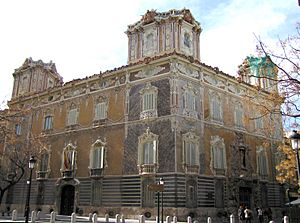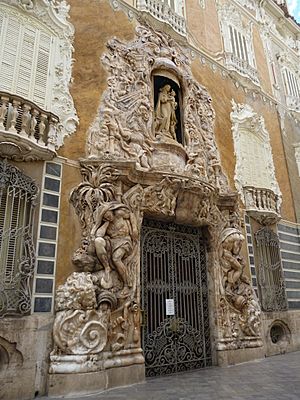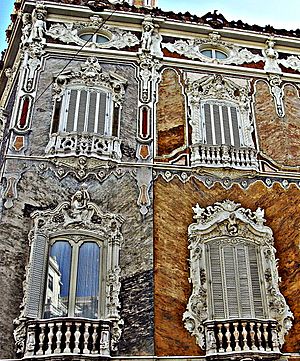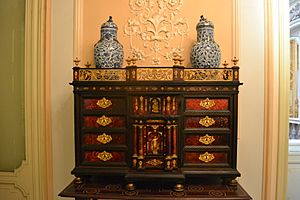Palace of the Marqués de Dos Aguas facts for kids
Quick facts for kids Palacio del Marqués de Dos Aguas |
|
|---|---|
| Native name Palacio del Marqués de Dos Aguas (Spanish) Palau del Marqués de Dosaigües (Catalan) |
|
 |
|
| Location | Valencia, Spain |
| Official name: Palau del Marqués de Dosaigües designation1_date = | |
| Type | Non-movable |
| Reference no. | RI-51-0001213 |
| Lua error in Module:Location_map at line 420: attempt to index field 'wikibase' (a nil value). | |
The Palace of the Marquis of Dos Aguas (in Spanish: Palacio del Marqués de Dos Aguas, in Valencian: Palau del Marqués de Dosaigües) is a beautiful old palace in Valencia, Spain. It's famous for its amazing Rococo style. This grand building was once home to a very important noble family, the Marqueses of Dos Aguas. Today, the Spanish government owns it. Inside, you can find the González Martí National Museum of Ceramics and Decorative Arts. It's a great place to learn about old art and history!
The family who owned the palace, the Rabassa de Perellós, became very rich. They made their money through trade and by managing taxes for the government. This family was very powerful in Valencia for many centuries. They were known for their wealth and high social status.
Historians believe the palace might be built on an ancient Roman burial ground. This is because some old Roman findings were discovered in one of its courtyards in 1743.
Contents
Exploring the Palace's History
The palace has changed a lot over time. It started as a Gothic building around the 1400s. Back then, it had three parts built around a central courtyard. It also had a tall tower and a special entrance.
How the Palace Changed in the 18th Century
In the 1700s, the palace got a huge makeover. The 3rd Marquis of Dos Aguas, Ginés Rabassa de Perellós y Lanuza, wanted to show off his family's power. He hired famous artists like Hipólito Rovira Meri (a painter) and Ignacio Vergara (a sculptor).
Hipólito Rovira painted the outside walls with colorful scenes. These paintings, however, faded over time and were repainted by other artists.
The Palace's Look Today
The palace you see today looks mostly like it did after the 18th-century changes. A wavy balcony was added above the main entrance. A second tower was also built on the other side of the palace.
Inside, the floors were decorated with colorful tiles showing mythological stories. The stairs had beautiful plant designs. The walls were covered with fancy fabrics and paintings.
The Main Entrance: A Work of Art
The main entrance is the most striking part of the palace. It's made from a special stone called alabaster. Ignacio Vergara, a famous Valencian sculptor, created it based on designs by Hipólito Rovira.
This amazing entrance, built in 1745, tells a story. It represents the two biggest rivers in Valencia: the Turia and Júcar. You can see two large human figures, like strong Atlanteans, representing these rivers. Below them, two buckets pour out water, a clear nod to the "Dos Aguas" (Two Waters) in the Marquis's title.
On the right side of the entrance, you'll spot two crocodile heads, a quiver of arrows, and a pot pouring water. Above this, ivy vines with a snake curling around them add to the design.
On the left, there's a lion lying down, another pot pouring water, and more arrows. A giant figure rests his foot on the lion's back. The whole entrance is covered in detailed plant designs and even a palm tree.
The entrance also features the complex shield of the Marquises. It shows symbols from the Rabassa de Perellós family and other noble families they married into. Two wild figures with clubs protect the shield. You can see pears (for Perellós), and symbols for other families like Lanuza and Rocafull.
Above the entrance, in a special space, there's a statue of the Virgin of the Rosary. She was chosen as a special protector by the House of Dos Aguas. At her feet are two kneeling women. One holds a cornucopia (a horn overflowing with fruits), showing farming and wealth. The other has coins spilling from a pot, representing fairness and generosity. Two small winged sirens are on either side of the Virgin.
The whole entrance shows the rich and fancy Rococo style. Above the Virgin, an angel with a trumpet represents "Fame." This angel announces the greatness of the Marquisate of Dos Aguas. The original Virgin statue was made in 1740 but disappeared. The one you see now is a plaster copy from 1866. The statue can even be hidden behind a lid! When the Marquises were away, the Virgin was hidden. When they were home, she was shown to the public.
The Carriage Entrance
On another side of the palace, there's a simpler entrance called the "Carriage Entrance." Its name tells you exactly what it was used for! This door, built between 1864 and 1867, is made of oak and walnut wood. It's decorated with designs of rockeries and fruits. You can also see two masks of the Greek god Pan (or Faun in Roman myths). Look closely for the metal letters "MD" for "Marqués de Dos Aguas."
A charming fountain sits in the small area outside this entrance.
Decorations on the Outside Walls
The ceilings of the palace's arches are painted with figures from Greek and Roman myths, like Minerva, Ceres, Jupiter, and Mercury. These paintings rest on four decorated supports. They show the four parts of the world known at the time: America with a caiman, Africa with a lion, Asia with an elephant, and Europe with a horse.
Later, between 1862 and 1867, balconies were added with more decorations. Figures of cherubs, horns of plenty, masks, and classical statues were added everywhere. Some female figures look like fantastic creatures. The towers are decorated with shields and crests. The outside walls are painted to look like pink and gray marble. Terracotta eagles and scrolls decorate the tops of the towers.
Among the mythical figures on the facade, you might spot sirens. These are half-women, half-fish creatures with wings. Another figure is Aurora, a female figure who lights a torch every morning to bring the sun.
The Inner Courtyard
The inner courtyard, also called the "Fountain Courtyard," once had Gothic windows. These were replaced with Rococo balconies. These balconies have clay figures of gods and goddesses, showing the Marquis's interests.
In the middle of the courtyard, there's a small marble fountain. Its main feature is a child riding a swan. This same design can be found in the Jardines de Monforte nearby.
Between 1991 and 1998, a glass roof was added to protect the courtyard from the weather.
Levels of Decoration
The palace's decorations are arranged in different levels. On the lower level, you'll see figures representing the Fine Arts. For example, architecture is shown by a woman holding a palace plan. Sculpture is shown by a woman with a statue bust. Other figures represent agriculture (a woman with fruits) and labor (a spinner).
Near the entrance to the palace's inside, there are two statues of goddesses from Olympus. On the left is Demeter-Ceres, holding a horn of plenty, symbolizing abundance. On the right is Athena-Minerva, the goddess of wisdom, with a shield and helmet.
On the upper level, decorating the balconies, more figures represent different ideas:
- The Sciences and Letters: Shown by Athena-Minerva with books and astrolabes.
- War: Also shown by Athena-Minerva.
- Trade: Represented by Mercury-Hermes with his special staff and winged hat.
- Hunting: Shown by Artemis-Diana with hunting tools and a deer.
- Maritime interests: Represented by Poseidon-Neptune with his trident and sea creatures.
- Arts: Shown by Apollo-Phoebus with a lyre.
On the very top level of the balconies, there are six round decorations with busts (head and shoulders statues) of gods like Apollo, Athena, Dionysus, Flora, Demeter, and Helios.
All these decorations show what the Marquis liked, what he was interested in, and how his family became rich.
Inside the Palace
The inside of the palace was also beautifully decorated with paintings and marble floors. The Marquis used to host famous dances here, inviting singers and musicians to Valencia.
Many artists worked on the palace's interior in the early 1800s. For example, José Flores Vela painted the ceilings of the Chinese-style hall. Rafael Montesinos y Ramiro decorated the dining room.
The walls inside are covered with a special plaster made from alabaster. This alabaster came from mines near the village of Dos Aguas, which is where the Marquisate gets its name!
You enter the palace through the main entrance, then cross the courtyard. From there, a door leads inside. It's guarded by two sculptures: Saint Agnes with a lamb, and the goddess Ceres. Next to Saint Agnes, there's a bronze bust of Don Manuel Gonzalez Martí, who founded the museum. Above the door, two carvings show silk and farming.
Climbing the stairs, you reach the first floor and the first room:
The Lobby
This room has a statue of the goddess Flora made of Carrara marble. At the entrance to the lobby, you'll see the Marquisate's shield. It's held up by two strong figures representing Spain. From the lobby, you can go to the garden terrace or the Hall of Illustrious Figures.
The Garden Terrace
This area was created in the 20th century to make the palace work better as a museum. It's actually one of the inner courtyards that was covered over. It has a mix of 18th-century ceramic panels and garden furniture with mosaics from around 1900. A skylight was added to bring light into the lower part of the courtyard.
Hall of Illustrious Figures
This room has an unusual shape and is decorated with plaster carvings. It's called the Hall of Illustrious Figures because it displays five paintings of famous people from Valencia. These paintings, made by Jose Brel Giralt, include Joan de Joanes, Juan Luis Vives, Ausias March, Ignacio Vergara, and Guillén de Castro. Above them, there's a decorative border with images of child musicians and grapes. This room was originally the entrance to the ballroom, built around 1863.
Far Eastern Hall or Tearoom
This room is named for its unique oriental-style decoration, which was very popular at the time. The decorations were done by José Flores Vela and his brother Vicente Pérez Vela. In the corners, there are small temples inspired by Mongol design, meant to hold Japanese vases and porcelains. The black oriental furniture is original from that period.
The Dining Room
In the center of the dining room ceiling, there's an oval-shaped painting called "The Light Fecundating to the Creation." It was painted by Rafael Montesinos Ramiro in 1862.
The painting shows figures representing the four parts of the world: Africa with a lion, America with a parrot, Europe with a horse, and Asia with an elephant.
The room's plaster decorations feature themes of hunting, food, fishing, gathering, and farm life. Four female busts, representing the four seasons, are especially notable. They were made by José Nicoli.
The Smoking Hall
This room was for relaxing, smoking, and drinking coffee. The ceiling has paintings by Julio Cebrián Mezquita from 1890, showing cherubs among flowers. In the corners, there are four small round paintings of flowers by the same artist. The furniture in this room is very fancy. A 17th-century Flemish tapestry hangs on one wall.
The Oratory
This is a prayer room with two sections, each having an oval painting. These paintings, by José Brel in 1863, show two scenes about the Glory of Mary. One shows Mary triumphing over evil, stepping on a serpent. The other shows angel musicians singing praises to Mary. A Latin phrase on the painting says, "Hail Queen of Heaven, Alleluia."
The lower parts of the walls have plaster carvings showing scenes from the Old and New Testaments. These were made by Francisco Molinelli in 1866. The oratory is dominated by an altar with a statue of the Virgin of the Rosary, the patron saint of the Marquisate of Dos Aguas. This statue was made in 1866 by José María García Martinez.
Images for kids
See also
 In Spanish: Palacio del Marqués de Dos Aguas para niños
In Spanish: Palacio del Marqués de Dos Aguas para niños







